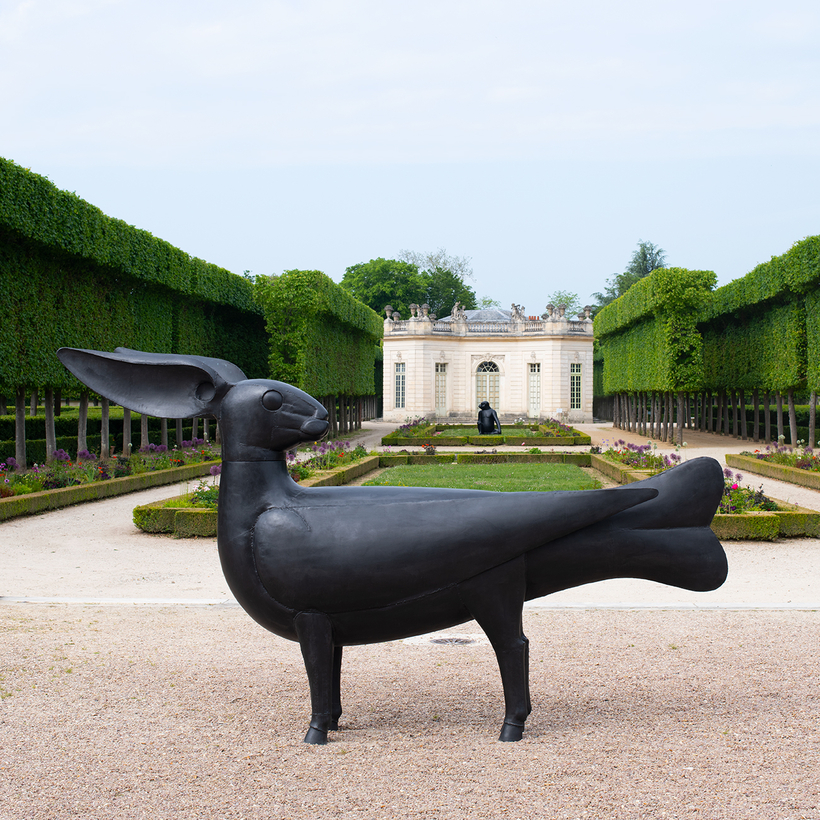Yves Saint Laurent, an early patron of the artist duo Les Lalanne, delighted in the flock of woolly sheep that he bought from the Alexandre Iolas Gallery, in Saint-Germain-des-Prés, and kept in his apartment on the Rue de Babylone. The designer often joked that they allowed him to pretend he was on a farm in Normandy, an aspiration he shared with the last queen of France.
There is a delicious irony in the concept of a Les Lalanne exhibition at the estate of the Petit Trianon, at Versailles. A masterpiece of picturesque landscape gardening when it was created, the park was designed with the sole purpose of delighting the senses and charming long-gone aristocratic revelers. The queen worked with her architect Richard Mique to create her fantasy court, adding the Temple of Love, the Queen’s Theatre, the Belvedere Pavilion, an artificial waterfall, and the Hameau de Reine (Queen’s Hamlet)—a royal play farm. Presented to Marie Antoinette after the birth of her first child, the garden was meant to provide escape from the rigid routine of palace life.

Have the Lalanne sheep—sculptures that for decades transformed elegant urban interiors into rural idylls—finally found their way home to the one place that could fairly be described as the mother of all rural idylls, Marie Antoinette’s picturesque little village?
The sheep are the works that launched the French couple François-Xavier and Claude Lalanne. They were an immediate hit with the jet set, the first edition snapped up by Gianni Agnelli, Gunter Sachs, Guy and Marie-Hélène de Rothschild, and Saint Laurent. Now they’re joined by other pieces—Bar aux Autruches, a tray held on each side by the beak of an ostrich, in iron and porcelain; Banquette Crocodile, a crocodile-studded bench in bronze and copper; and Lit Cocodoll, a brass-and-canvas bed on a steel frame, complete with a massive bird’s head—for the largest-ever outdoor exhibition of Les Lalanne.
The works are arranged throughout the Gardens of Versailles by the art dealer and gallerist Jean-Gabriel Mitterrand and curator Laurent Salomé, director of the Palace of Versailles. “For this exhibition we first had to visit the park, gardens, and pavilions many times,” says Mitterand. “We came to the conclusion that each sculpture had had its own place for as far back as three centuries ago!”
This is certainly true of Olympe, a delightful bronze fountain modeled on Claude’s granddaughter and adorned with delicate cabbage-leaf wings. It is positioned in the pond at the Belvedere. Meanwhile, Choupatte Géant, a large version of the classic Lalanne cabbage with chicken feet, is placed in the French Pavilion. And the brilliant Poisson Paysage, a big bronze fish with a rectangular viewing box in its midsection, is set swimmingly in the meadow between the Grand Lac and the farm.
The show opens with Claude Lalanne’s Pomme de New York, an oversize bronze apple situated just opposite Marie Antoinette’s Temple of Love.

A piece by Les Lalanne has always been desirable, but their work—also the subject of an exhibition at Williamstown’s Clark Art Institute—is currently setting the auction houses on fire, regularly achieving six times the estimate. Mitterand says, “If the whole world is now collecting Les Lalanne, it comes from the perfection, the power of seduction, of each sculpture or design—the fundamental idea to bring a use to each work and to follow the tradition of French style and elegance with a Surrealist background.”
The couple worked in the great French tradition of craftsmanship, preparing models for casting by the best artisans while they worked on the details and patinas back in the studio. For many years Les Lalanne lived next door to Constantin Brancusi. They were also influenced by their neighbor, the American sculptor James Metcalf.
Les Lalanne discovered the space between fine and decorative art and made it their own. The pieces follow naturalistic themes and possess a highly developed sense of humor. Playing with scale, function, and composition, the couple’s works generate gentle confrontation, momentarily pushing the viewer beyond the boundaries of normality. We return to reality with an expanded sense of possibility and delight. And where better to experience delight than at the Petit Trianon? —Sarah Hyde

 Discover
Discover